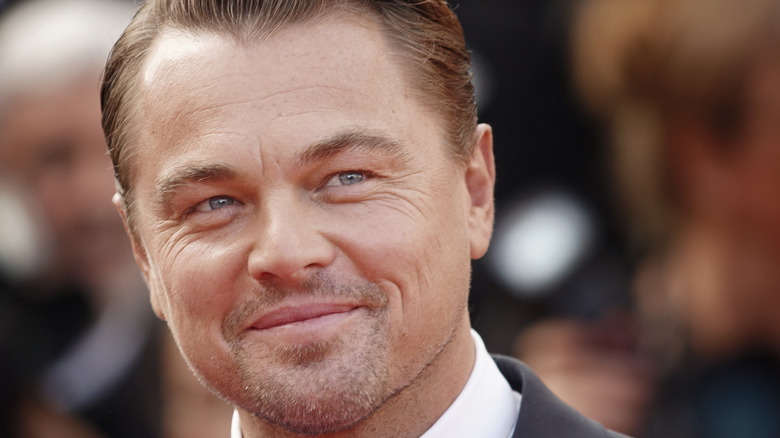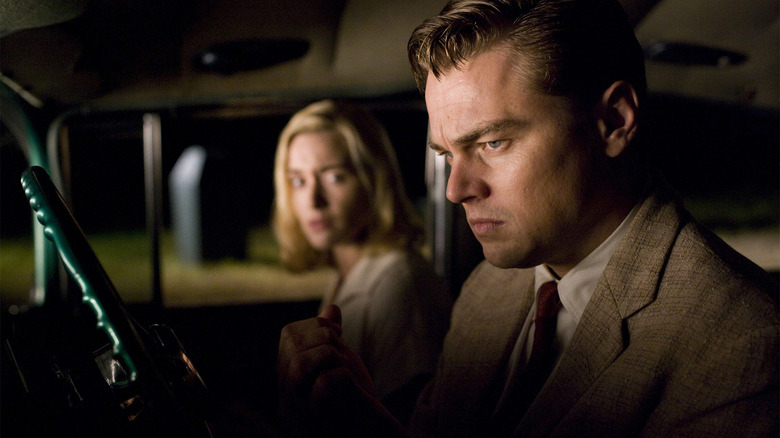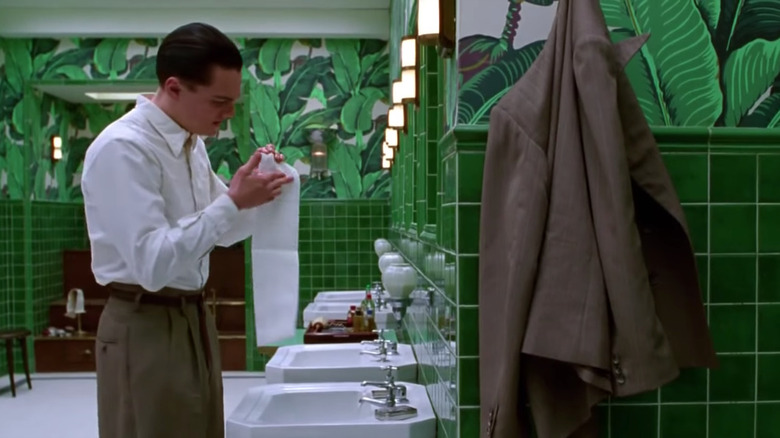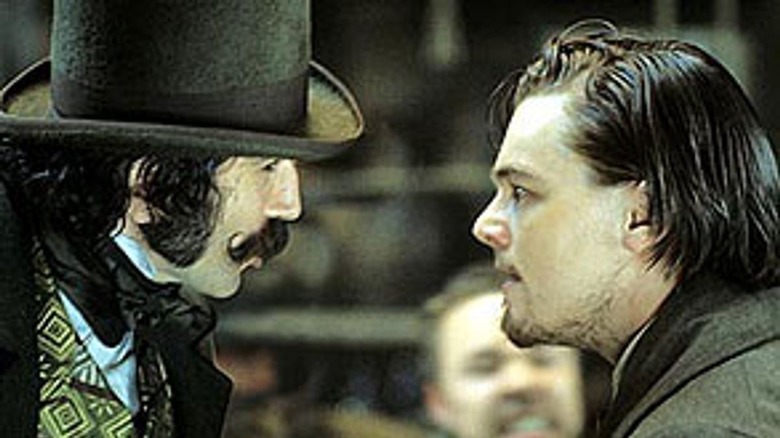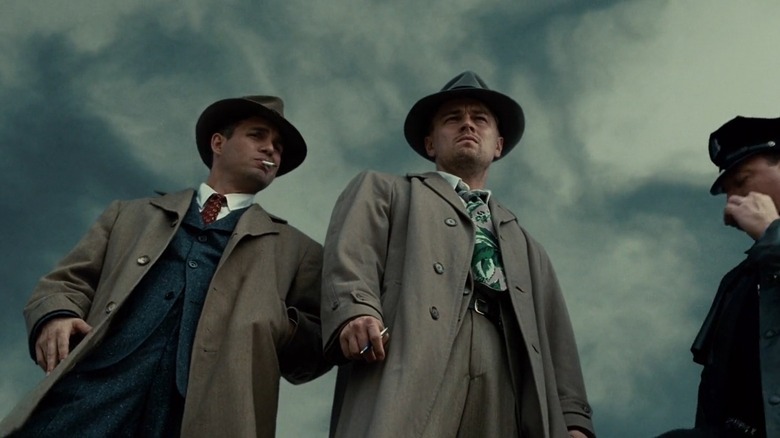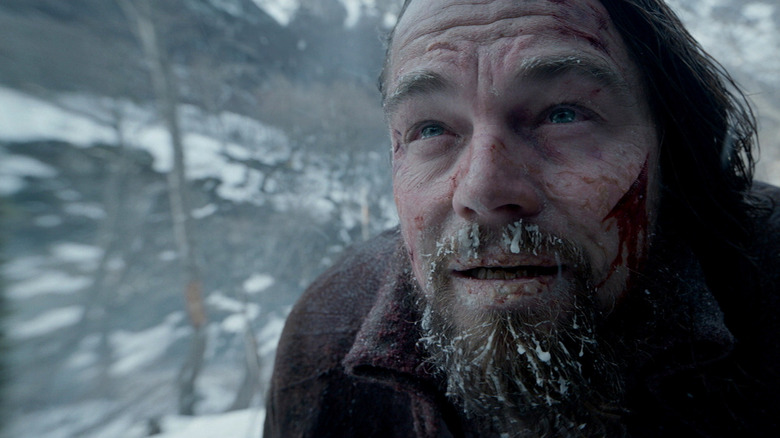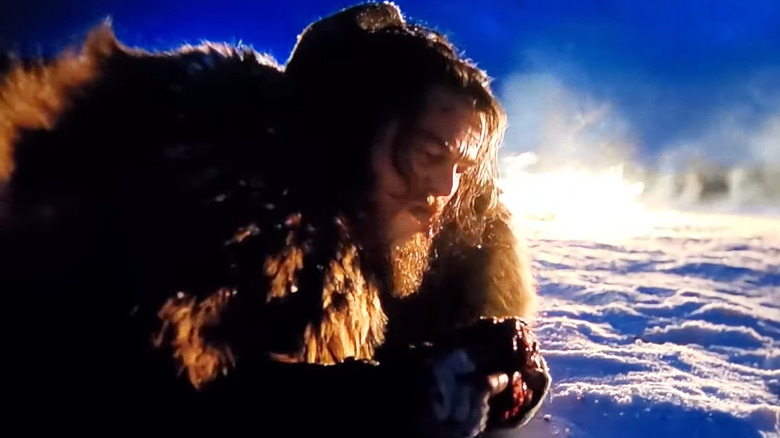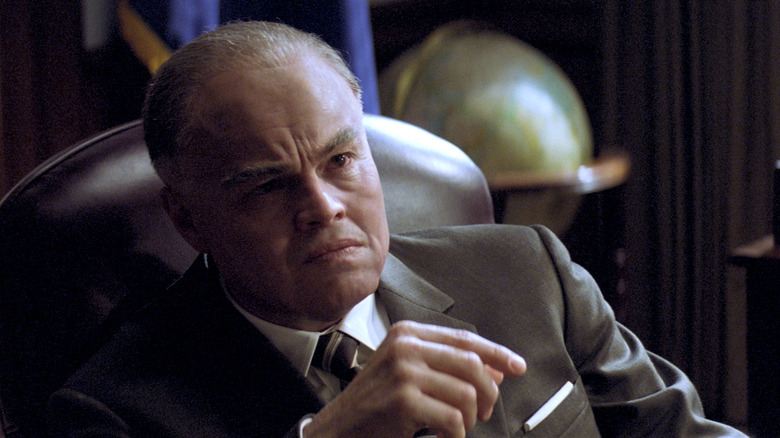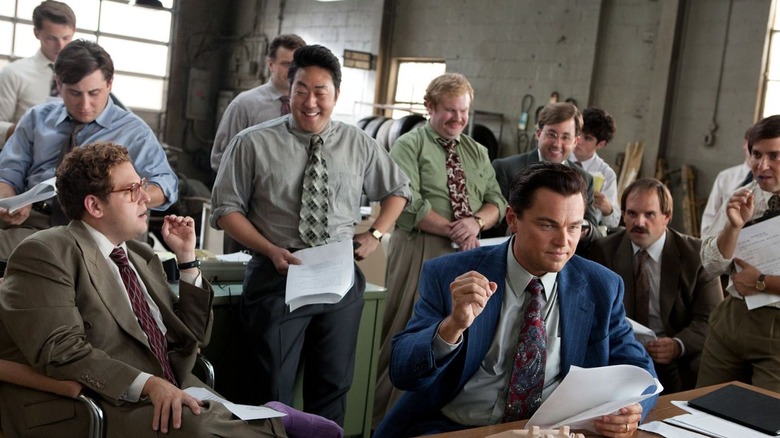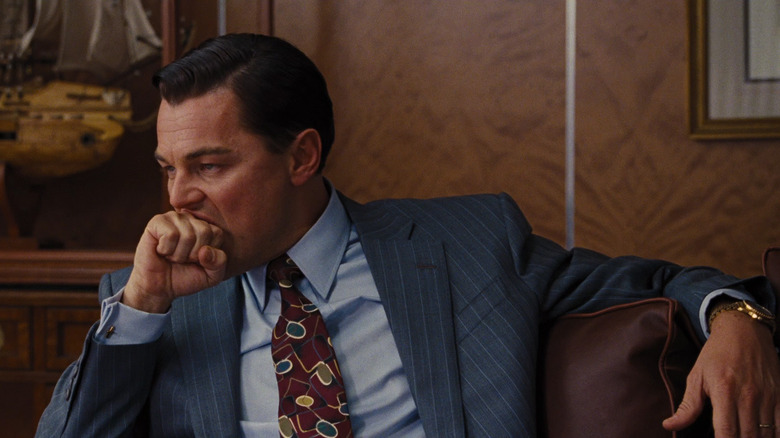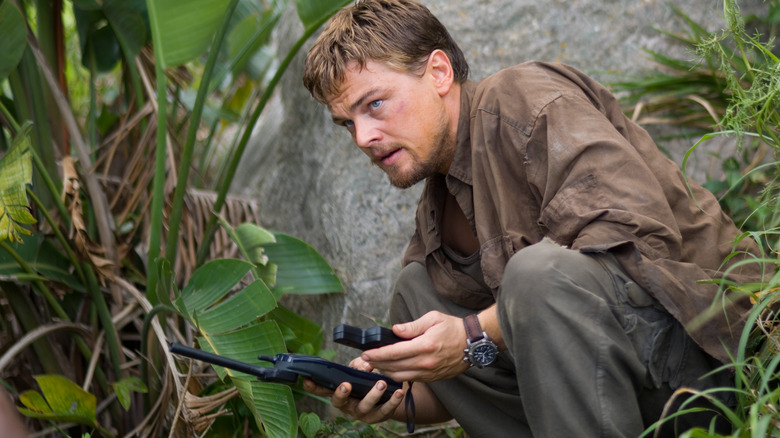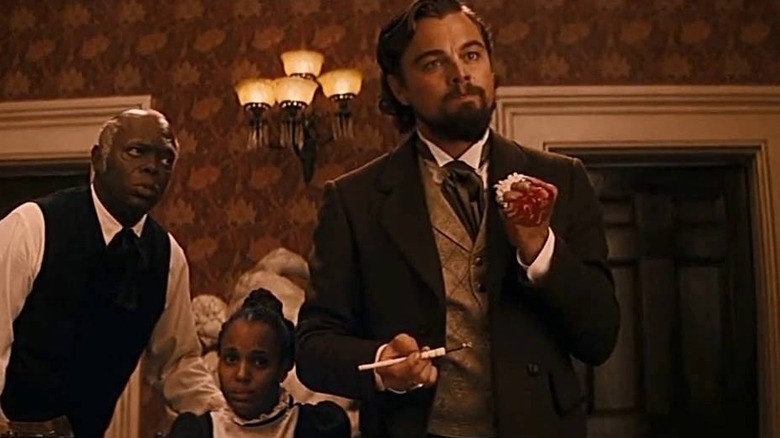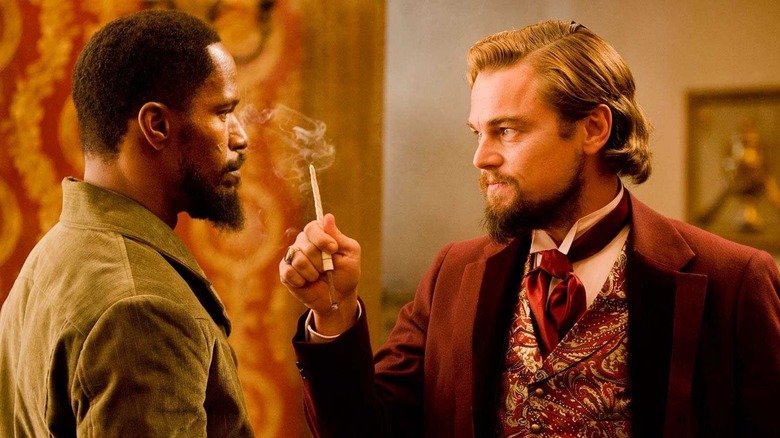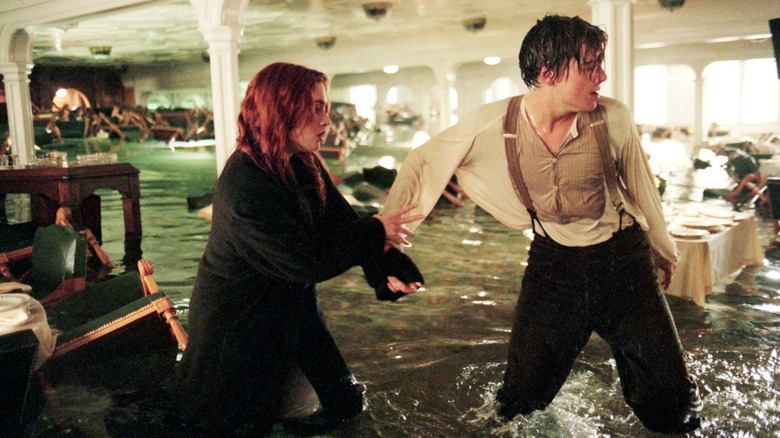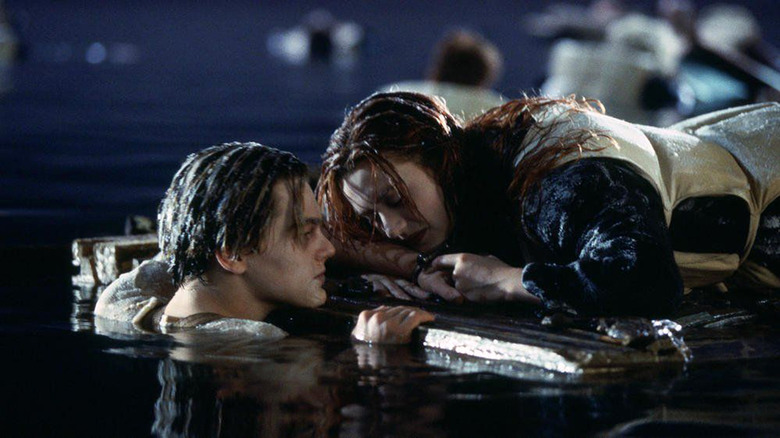The Worst Things Leonardo DiCaprio Has Done For His Roles
It is a generally accepted fact that the age of superstars in Hollywood is antiquated. Studios are all about franchises and pre-existing IP these days. But in this era of endless sequels, reboots, and spinoffs, Leonardo DiCaprio stands as the rare example of an old-fashioned movie star who has managed to remain A-list without relying on franchises or big-budget blockbusters.
DiCaprio got his start in the entertainment industry at a young age, when he did pretty much any role that was available. But as his stock rose, the young actor became pickier about his projects, collaborating with visionary auteurs like Sam Raimi ("The Quick and the Dead"), Baz Luhrmann ("Romeo + Juliet") and most famously, James Cameron's "Titanic."
Keep in mind, that was before he became a superstar. Post-1997, DiCaprio only further emphasized auteurs over opening weekend potential, famously working multiple times with names like Scorsese and Tarantino, in addition to Nolan, Boyle, Mendes, Ridley Scott and more.
Despite following a career path increasingly unavailable to his peers, DiCaprio has managed the near-impossible task of consistently putting out box-office hits, even winning an Oscar, without superheroes, without TV-to-movie-adaptations, without sequels. It's all extremely impressive; nonetheless, here are the worst things DiCaprio has had to do to make it happen.
Dealing with claustrophobia
Few onscreen couples in the history of Hollywood have the sort of cultural currency enjoyed by Jack and Rose from "Titanic." The characters were brought to life with aching sincerity by DiCaprio and Kate Winslet, and ever since then fans have clamored for the duo to set the screen on fire with their passion once again.
So audiences were excited about 2008's "Revolutionary Road," even if all involved with the film were eager to do a bit of a bait-and-switch. The Sam Mendes film, based on a brutal 1961 Richard Yates novel, would give viewers looking for Jack and Rose something more like "The War of the Roses."
DiCaprio and Winslet play a couple, Frank and April, in the mid-1950s that are struggling with a failing marriage. Rather than playing two people falling in love, they had to portray a couple falling out of it, and the actors had to film very intense, emotional scenes in closed-in locations.
This style of filming for days at a time took a toll on DiCaprio's mental well-being. Despite working with his longtime friend and colleague Winslet, the actor was glad to finally wrap up the shoot for "Road" and say goodbye.
"It was depressing, making this film," the actor admitted in a 2008 interview with GQ. "There was no way to get out [of the cramped sets while making the film]; there was nowhere to run. The claustrophobia was pretty intense after a while."
Picking up compulsive habits
Leonardo DiCaprio has played a number of historical figures; perhaps the most notable of these was industrialist Howard Hughes in "The Aviator." A big part of Hughes' personality that DiCaprio needed to pay attention to was his battles with Obsessive Compulsive Disorder (OCD).
For 2004's "The Aviator," the actor immersed himself in the world of Hughes and his mental afflictions. Doing such a deep dive meant that DiCaprio's personal life started to be impacted. Most significantly, his own issues with OCD during childhood began to resurface. During interviews that accompanied the release of the movie, DiCaprio implied that he had full-on OCD as a child, but he later clarified his remarks in a separate interview.
"I never actually had OCD," DiCaprio said in 2008. "I know I did say that at some point, but I didn't."
He went on to explain that while playing Hughes, DiCaprio had forced himself to bring back certain compulsive habits from his childhood, which then stuck with him for many months afterwards. "I was going around stepping on cracks," the actor mentions in the same interview. "And for some reason, at airports I had to step on every stain that I saw, so I'd be darting around doing that."
Matching Daniel Day-Lewis scene-for-scene
Any discussion of actors who go to extreme lengths for their roles has to begin with Daniel Day-Lewis, who stands apart in a class of his own. The actor is also famously reclusive and picky about the roles he does. In 2002, Martin Scorsese brought together DiCaprio and Day-Lewis in the period crime epic film "Gangs of New York."
Naturally, Day-Lewis went all in for his role as villainous "Bill the Butcher." As the protagonist Amsterdam Vallon, DiCaprio has a number of scenes where his character gets into physical altercations with Bill and his associates. Normally such scenes would be done using body doubles and stuntmen. But the presence of Day-Lewis made DiCaprio feel compelled to step up and do the scenes himself.
"I'm sure Leo probably wanted a stunt man," the film's producer told Vulture (via /Film), "But Daniel says, 'We don't need them, do we, lad?' And he says, 'Of course not.'" The sense of one-upmanship did not end there, as another scene involving a fight between Bill and Amsterdam saw DiCaprio and Day-Lewis trading blows before the scene was shot to get themselves into the right frame of mind.
Confronting mental trauma
Although DiCaprio is best known as a dramatic actor, he has also dipped his toes into other genres including mystery-thrillers. In 2010 he and Scorsese teamed up for "Shutter Island," a psychological thriller set in a mental asylum in the 1950s.
DiCaprio plays the role of a US Marshal named Edward "Teddy" Daniels, sent to Ashecliffe Hospital for the Criminally Insane on lonely, remote Shutter Island. Arriving on the island, Teddy is unsettled by the atmosphere of madness surrounding the hospital and its mentally ill patients, who suffer from a range of problems related to violence and crime. The process of making the movie meant DiCaprio had to immerse himself in the world of mental trauma and the neglect of those who suffer from it by society, and the experience left him quite shaken.
"[The process of making the movie] was really very traumatic," DiCaprio admitted in an interview with Parade.com (via TODAY). "And I don't say that about a film very often." The actor also calls the process of shooting almost the entire movie locked inside a mental asylum "one of the most intense, hardcore filming experiences" of his life, one that impacted his sleep cycle as well as his waking hours.
Dealing with hypothermia
For most of his career, DiCaprio avoided big-budget action movies. That meant he was largely free of the kind of bodybuilding, stunt practice, and martial arts training that so many actors who become the face of action franchises have to undergo. But then DiCaprio did 2015's "The Revenant" and found himself doing some of the most difficult action scenes in recent Hollywood history.
Much has been written about the physical lengths the actor went to while portraying the film's main character, a frontiersman during the 1800s left to die in the wild by a duplicitous comrade, forced to trek single-handedly across the frozen tundra in extreme conditions to get back home. Director Alejandro G. Iñárritu wanted to keep the character's journey as authentic as possible, which meant shooting on location and making DiCaprio go through as much of the arduous trek as possible, including sleeping inside an actual animal carcass.
All this took an extreme toll on DiCaprio's body. "[During the shoot I was] enduring freezing cold and possible hypothermia constantly," the actor told Yahoo! in an interview. It did not help that his character swims through frozen rivers at certain points in the film, which meant that DiCaprio had to personally dive into the rivers instead of relying on a stuntman in keeping with Iñárritu's commitment to authenticity.
Eating raw bison liver
"The Revenant" often feels like an extended episode of "Man vs. Wild," where Leonardo DiCaprio's character Hugh Glass takes the place of Bear Grylls in trying to survive in a harsh, frozen landscape using nothing but his wits and anything he happens to come across while on his journey. And just like Grylls, Glass often has to rely on unsavory, unexpected meals.
In one memorable sequence, Glass is forced to eat raw bison liver for sustenance in the absence of literally any other sort of food. The scene serves to underline the desperation of the character as he eagerly begins devouring the uncooked meat to stave off hunger and death. As it turns out, DiCaprio wasn't purely acting in that scene; he was actually chowing down on raw bison liver.
"I certainly don't eat raw bison liver on a regular basis," the actor told said about shooting the scene. "When you see the movie, you'll see my reaction to [eating raw liver], because [director] Alejandro [Iñárritu] kept it in. It says it all. It was an instinctive reaction." In another interview with Variety, DiCaprio revealed that the film crew had initially prepared a fake, eatable liver, but he worried that it did not look realistic enough, and arranged to have the real thing served as his meal for the scene.
Lots of makeup time
Leonardo DiCaprio is often counted among the most good-looking men in Hollywood. Naturally, filmmakers are eager to take advantage of the actor's appeal to female viewers, so his face is often left untouched by prosthetics or too much makeup. But 2011's "J. Edgar" saw DiCaprio decked out in full prosthetic glory for the sake of his character.
Once again the actor plays a real-life personality, the director of the FBI during its early years, J. Edgar Hoover. DiCaprio portrays Hoover's beginning as a young man starting out in government service all the way up to his final days in his 70s. DiCaprio's famous visage is barely recognizable under mounds of prosthetics and makeup, and the process of transformation required for such scenes was anything but easy.
"Leo's been subjected to some very long makeups by me in the past," DiCaprio's personal makeup artists since "Titanic," Sian Grigg, said in 2011. "But this film is his most challenging."
Not only did DiCaprio endure several hours of makeup being applied to his body, but he also "spent hours every day walking and talking with fake teeth, a nose stretcher, aging makeup and a skullcap."
Eating until he threw up
While you can't beat "The Revenant" when it comes to placing actors in impossible filming conditions, 2013's "The Wolf of Wall Street" was no cakewalk. With Scorsese at the helm, the focus was on keeping the movie's scenes of unbridled debauchery and greed as true-to-life as possible.
DiCaprio plays the lead role of Jordan Belfort, an ambitious stockbroker whose willingness to bend the law to get what he wants is matched only by his lust for the finer things in life (regardless of whether they are legal). DiCaprio had to do a whole lot of weird, outrageous things as Jordan, but ironically the one that taxed his body the most was a simple sequence involving food.
According to DiCaprio's co-star Jonah Hill, after the two filmed a fight scene where Hill took the brunt of things across multiple takes, he schemed to get back at DiCaprio, exacting his revenge when they were filming a scene where DiCaprio had to eat sushi.
Hill purposefully kept messing up the scene, forcing his co-star to eat more sushi than any human should at one sitting. "[DiCaprio] had to do 100 takes of eating over and over again and I was like, 'This is my revenge right here,'" Hill recalled in 2013. "By the end of the night, he was on the floor, throwing up into a waste bin and everyone was like, 'Leo, are you okay?'"
A really lit posterior
"The Wolf of Wall Street" is a dramatized version of the real life escapades of stockbroker-turned-criminal Jordan Belfort. Apart from fleecing his Wall Street clients for all they were worth, Jordan had an insatiable appetite for all sorts of debauchery. DiCaprio has a grand time showcasing this side of Belfort's nature in the movie.
All through the film, DiCaprio's character and his friends try to one-up each other in seeing who can do the most expensive, twisted thing for their personal gratification. One scene that particularly draws attention to this is when Jordan is seen with a dominatrix. Bored with regular intercourse, Jordan is trying to mix things up by sticking a lit candle up his butt.
The scene could have been filmed in an easy manner with some basic CGI or a body double for DiCaprio. But Margot Robbie, who plays Jordan's girlfriend Naomi in the film, threw the gauntlet down. "I was like, 'You know, if you were really committed to this character and wanted to do it authentically, you'd do [the stunt yourself]," Robbie told the LA Times in 2014. The rest is cinematic history.
Living with mercenaries
One tag that DiCaprio has managed to avoid his whole life is that of an "action hero." This despite the fact that the actor has taken on a number of high-octane action roles in his life in films like "Inception," "The Departed," and "The Revenant." One of the most intense action roles of the actor's career had him playing a South African mercenary in 2006's "Blood Diamond."
DiCaprio essays the role of Daniel "Danny" Archer, a Rhodesian smuggler and mercenary. The movie takes a look at the grim world of diamond mining in South Africa, where a man's life is worth much less than the diamonds he can mine and ship to first world countries. Danny comes across a miner possession of a blood diamond of unusual proportions, and has to move quickly to secure the man and the diamond from a ruthless warlord.
DiCaprio's performance in the movie was praised by critics, not only for his convincing South African accent but also for the action scenes where the actor goes all out depicting a man who has spent a lifetime surrounded by violence and cruelty. In order to get under the skin of his character, DiCaprio trained with actual mercenaries belonging to the region. This included living with them, learning how to handle a gun in training exercises, having long talks with ex-mercenaries and diamond experts, and soaking up the local culture as much as possible.
Injuring his hand mid-scene
Leonardo DiCaprio has one of the most impressive filmographies of any actor in the history of Hollywood. A major reason behind it is DiCaprio's habit of working with the best directors of the day, true auteurs whose films leave an indelible imprint on the minds of audiences. One such director is Quentin Tarantino, whom DiCaprio first collaborated with on 2012's "Django Unchained."
The film was a big departure from the norm for the actor because he was playing an out-and-out villain, a cartoonishly over-the-top slave plantation owner named Calvin J. Candie. For once, DiCaprio gets to chew the scenery with relish in his portrayal of Candie as a cruel, degenerate monster who is used to throwing his weight around his own plantation.
In one of the film's most intense scenes, Candie goes off on a rant about Phrenology. In the heat of the moment he strikes a table and smashes a glass sitting on top of it, cutting his hand, which starts bleeding profusely. That whole scene was not planned, and DiCaprio actually injured his hand.
"My hand started really pouring blood all over the table," DiCaprio told THR. "I wanted to keep going. It was more interesting to watch Quentin's and Jamie's reaction off-camera than to look at my hand." Tarantino was so impressed with the take that he decided to keep it in the film.
Saying the n-word
Despite playing out like a typical Western, "Django Unchained" is far more subversive and hard-hitting than other films in the genre. The movie deals squarely with America's past concerning slavery. The hero of the film is Django (Jamie Foxx), a former slave turned bounty hunter on a quest to rescue his wife Broomhilda (Kerry Washington) from a plantation.
Django's search leads him to Candie (DiCaprio), who owns the plantation where Broomhilda is forced to serve. As the main villain of a movie about slavery, Candie is the most viciously racist villain you could ever hope to see Django execute. For the sake of his character, DiCaprio had to say all manner of offensive things to his Black co-stars, including repeated use of the n-word.
DiCaprio, known for deeply committing to his role, had a hard time saying the word, even for the sake of the movie.
"The first day on set was incredibly difficult for me," the actor admitted to ABC News, recalling his struggle to use such strong language against his co-stars. One of them was Samuel L. Jackson, who bluntly told DiCaprio, "Get over it, motherf***er. It's just another Tuesday, motherf***er."
Getting wet while making Titanic
DiCaprio has done a lot of extreme stuff for his roles in movies. He has braved the elements in "The Revenant," grappled with OCD and mental trauma in "The Aviator" and "Shutter Island," and exchanged actual blows with Daniel Day-Lewis in "Gangs of New York." But it was the historical romantic epic "Titanic" which pushed the actor to his limits, thanks to its director James Cameron.
A notorious perfectionist known for paying great attention to detail, Cameron left no stone unturned in making sure his movie about the sinking of the Titanic would be as realistic and emotionally moving as possible. Since the third act of the film plays out like a disaster movie, DiCaprio and his co-stars had to perform a great many stunts while being fully or partially submerged in water to depict the sinking of the giant RMS Titanic ship.
According to Cameron, DiCaprio had a huge problem getting wet for those scenes. "He made a huge production out of getting into the water every time," the filmmaker told Brisbane Times (via NME). "He hated to get wet, or he pretended he hated to get wet." For his part, DiCaprio did not miss wrapping up the shoot for the movie. "After the whole experience," he told Vanity Fair at the time, "I know it's really not my cup of tea [to make something like 'Titanic'] — all respect to Jim and the actors who do that type of thing."
Joint bathroom trips
Making a movie like "Titanic" was difficult for everyone involved, from the production crew to the actors. All they had to keep them strong through the difficult shoot was director James Cameron's grand vision and his steely determination to bring the tragic historic event to life in as authentic a manner as possible.
As the lead actors playing Jack and Rose, DiCaprio and Kate Winslet depended upon each other greatly to get them through take after take of their scenes. Fortunately, the two actors hit it off immediately and became very good friends while making "Titanic." In fact, they got so comfortable with each other that they even suffered through relieving themselves in the same water tank area while shooting Jack's iconic death scene.
The sequence necessitated Winslet and DiCaprio staying submerged in the tank for hours at a time for filming, with only each other for company. "Leo would sometimes say to me, 'Sweetie, sweetie, I gotta pee.'" Winslet told Rosie O'Donnell in 1998. "I'd go, 'So have I.'"
The actors would have to take turns swimming to a corner of the tank to relieve themselves. "You always felt awful doing it," Winslet admitted in the same interview. "But it took too long to get out in the wet clothes."
